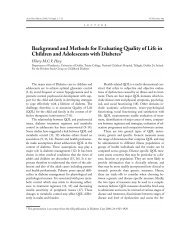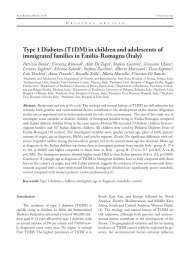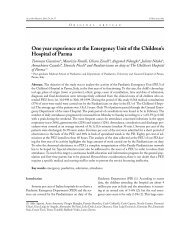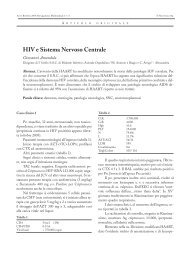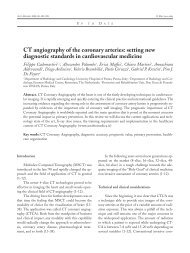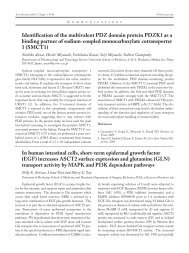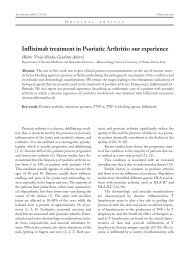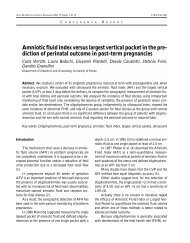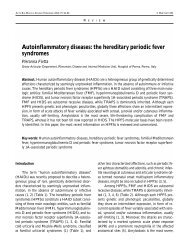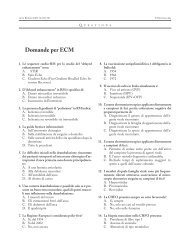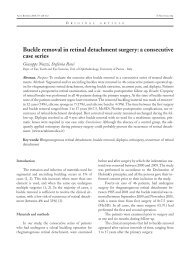Contribution of studies on renal effects of heavy metals and selected ...
Contribution of studies on renal effects of heavy metals and selected ...
Contribution of studies on renal effects of heavy metals and selected ...
You also want an ePaper? Increase the reach of your titles
YUMPU automatically turns print PDFs into web optimized ePapers that Google loves.
Toxic nephropathies from industrial chemicals<br />
65<br />
Moreover, the urinary excreti<strong>on</strong> rate <str<strong>on</strong>g>of</str<strong>on</strong>g> albumin <strong>and</strong><br />
fibr<strong>on</strong>ectin correlates with the histopathological semiquantitative<br />
scoring for interstitial infiltrati<strong>on</strong> <strong>and</strong> fibrosis.<br />
Indirect evidence <str<strong>on</strong>g>of</str<strong>on</strong>g> mechanisms increasing the<br />
producti<strong>on</strong> <str<strong>on</strong>g>of</str<strong>on</strong>g> reactive oxygen species was obtained<br />
from the parenchymal c<strong>on</strong>centrati<strong>on</strong> <str<strong>on</strong>g>of</str<strong>on</strong>g> 8-hydroxy-2-<br />
deoxyguanosine DNA adduct <strong>and</strong> gluthathi<strong>on</strong>e depleti<strong>on</strong>,<br />
two associated phenomena.<br />
This animal model c<strong>on</strong>firmed the role <str<strong>on</strong>g>of</str<strong>on</strong>g> hydrocarb<strong>on</strong><br />
exposure as a factor accelerating the progressi<strong>on</strong><br />
<str<strong>on</strong>g>of</str<strong>on</strong>g> <strong>renal</strong> disease indicated by epidemiological investigati<strong>on</strong>s<br />
in patients suffering from chr<strong>on</strong>ic <strong>renal</strong><br />
disease (57, 58), thus suggesting the need to avoid solvent<br />
exposure in patients suffering from <strong>renal</strong> diseases.<br />
C<strong>on</strong>clusi<strong>on</strong><br />
Although clinical, epidemiological <strong>and</strong> experimental<br />
<str<strong>on</strong>g>studies</str<strong>on</strong>g> can be affected by methodological issues<br />
producing sometimes inc<strong>on</strong>sistent results, they<br />
should be c<strong>on</strong>sidered as complementary approaches.<br />
Experimental <str<strong>on</strong>g>studies</str<strong>on</strong>g> are essential to recognize potentially<br />
nephrotoxic compounds, to derive thresholds<br />
<strong>and</strong> safe doses, to study the mechanisms resp<strong>on</strong>sible <str<strong>on</strong>g>of</str<strong>on</strong>g><br />
the progressi<strong>on</strong> towards severe kidney impairment <strong>and</strong><br />
late-stage disease.<br />
The target selectivity <str<strong>on</strong>g>of</str<strong>on</strong>g> some <strong>metals</strong> or organic<br />
chemicals, which can <strong>on</strong>ly be supposed <strong>on</strong> the basis <str<strong>on</strong>g>of</str<strong>on</strong>g><br />
field <str<strong>on</strong>g>studies</str<strong>on</strong>g> in occupati<strong>on</strong>ally exposed workers, has<br />
been c<strong>on</strong>firmed in <strong>selected</strong> nephrotoxicity <str<strong>on</strong>g>studies</str<strong>on</strong>g>,<br />
combining acute, subacute <strong>and</strong> chr<strong>on</strong>ic designs. The<br />
above <str<strong>on</strong>g>studies</str<strong>on</strong>g> have clarified, in part, the mechanisms<br />
underlying the different pattern <str<strong>on</strong>g>of</str<strong>on</strong>g> biomarkers used to<br />
assess early changes in <strong>renal</strong> integrity <strong>and</strong> functi<strong>on</strong>,<br />
al<strong>on</strong>g with their meaning. However, a full validati<strong>on</strong> <str<strong>on</strong>g>of</str<strong>on</strong>g><br />
biomarkers should rely <strong>on</strong> follow-up <str<strong>on</strong>g>studies</str<strong>on</strong>g> indicating<br />
the health significance <str<strong>on</strong>g>of</str<strong>on</strong>g> observed changes. Microalbuminuria<br />
<strong>and</strong> low-molecular weight proteinuria fulfil<br />
this c<strong>on</strong>diti<strong>on</strong> in subjects suffering from diabetes mellitus<br />
<strong>and</strong> from chr<strong>on</strong>ic cadmium pois<strong>on</strong>ing, respectively.<br />
In such situati<strong>on</strong>s, both markers are predictors <str<strong>on</strong>g>of</str<strong>on</strong>g> an<br />
accelerated deteriorati<strong>on</strong> <str<strong>on</strong>g>of</str<strong>on</strong>g> <strong>renal</strong> functi<strong>on</strong>. Outside <str<strong>on</strong>g>of</str<strong>on</strong>g><br />
these two situati<strong>on</strong>s, no informati<strong>on</strong> is available to interpret<br />
the early changes resulting from chemical exposure<br />
<strong>and</strong> there is a need to c<strong>on</strong>duct l<strong>on</strong>gitudinal<br />
<str<strong>on</strong>g>studies</str<strong>on</strong>g> <strong>on</strong> populati<strong>on</strong>s with well-characterized exposure<br />
or risk. Therefore, when persistent microproteinuria<br />
is observed in the c<strong>on</strong>text <str<strong>on</strong>g>of</str<strong>on</strong>g> a documented chr<strong>on</strong>ic<br />
exposure to a suspected or established nephrotoxin,<br />
it is prudent to c<strong>on</strong>sider that it might have a similar<br />
meaning as in incipient diabetic or cadmium<br />
nephropathy (46, 47, 61). Such a view is corroborated<br />
by animal experiments, which support epidemiological<br />
<str<strong>on</strong>g>studies</str<strong>on</strong>g> suggesting that hydrocarb<strong>on</strong> exposure can accelerate<br />
the progressi<strong>on</strong> <str<strong>on</strong>g>of</str<strong>on</strong>g> <strong>renal</strong> disease towards chr<strong>on</strong>ic<br />
<strong>renal</strong> failure (59). This mechanism would be involved<br />
in several <strong>renal</strong> diseases, in which proteinuria is<br />
the main factor accelerating its cours (62, 63). In subjects<br />
with incipient <strong>renal</strong> disease, avoidance <str<strong>on</strong>g>of</str<strong>on</strong>g> exposure<br />
to <strong>heavy</strong> <strong>metals</strong> <strong>and</strong> volatile hydrocarb<strong>on</strong>s <strong>and</strong> their<br />
derivatives is essential to prevent end-stage <strong>renal</strong> disease.<br />
Acknowledgement<br />
The authors wish to thank Dr. Matteo Riccò for the collaborati<strong>on</strong>.<br />
References<br />
1. IPCS-UNEP-ILO-WHO. Principles <strong>and</strong> methods for the<br />
assessment <str<strong>on</strong>g>of</str<strong>on</strong>g> nephrotoxicity associated with exposure to<br />
chemicals. Envir<strong>on</strong>mental Health Criteria series, n. 119,<br />
World Health Organizati<strong>on</strong>, Geneva, 1991.<br />
2. Mutti A. Detecti<strong>on</strong> <str<strong>on</strong>g>of</str<strong>on</strong>g> <strong>renal</strong> diseases in humans: developing<br />
markers <strong>and</strong> methods. Toxicol Lett 1989; 46(1-3): 177-91.<br />
3. Berthoux F, J<strong>on</strong>es E, Gellert R, Mendel S, Saker L, Briggs<br />
D. Epidemiological data <str<strong>on</strong>g>of</str<strong>on</strong>g> treated end-stage <strong>renal</strong> failure in<br />
the European Uni<strong>on</strong> (EU) during the year 1995: report <str<strong>on</strong>g>of</str<strong>on</strong>g><br />
the European Renal Associati<strong>on</strong> Registry <strong>and</strong> the Nati<strong>on</strong>al<br />
Registries. Nephrol Dial Transplant 1999; 14: 2332–23.<br />
4. Dieperink HH. Identificati<strong>on</strong> <str<strong>on</strong>g>of</str<strong>on</strong>g> groups at risk for <strong>renal</strong> diseases<br />
(including nephrotoxicity). Toxicol Lett 1989, 46: 257-68.<br />
5. Bernard A, Lauwerys RR. Effects <str<strong>on</strong>g>of</str<strong>on</strong>g> cadmium exposure in<br />
man. In: Foulkes, E.C., ed. Cadmium toxicology. H<strong>and</strong>book<br />
<str<strong>on</strong>g>of</str<strong>on</strong>g> Experimental Pharmacology, Berlin, Heidelberg, New<br />
York, Springer-Verlag, 1986, Vol. 80, 136-77.<br />
6. Roels H, Lauwerys RR, Buchet JP, Bernard A, Vos A, Oversteyns<br />
M. A prospective study <str<strong>on</strong>g>of</str<strong>on</strong>g> proteinuria in cadmium<br />
workers. In: Bach, P.H. & Lock, E.A., ed. Nephrotoxicity:<br />
Extrapolati<strong>on</strong> from in vitro to in vivo, <strong>and</strong> animals to man,<br />
New York, L<strong>on</strong>d<strong>on</strong>, Plenum Press, 1989, 33-6.<br />
7. Nuyts GD, Van Vlem E, Thys J, et al. New occupati<strong>on</strong>al risk<br />
factors for chr<strong>on</strong>ic <strong>renal</strong> failure. Lancet 1995; 346(8966): 7-<br />
11.



